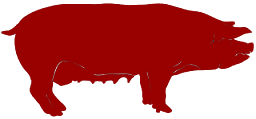MX/ LA/ MORE/ ???
Collection 2

Mexico
The majority of piggy banks from Mexico stand out because of their bracket and light weight. They may have been made of clay with volcanic ash. Before the great earthquake of 1985, you could regularly buy Mexican piggy banks in the Charity Shops. Not anymore after that.
No one knows exactly: Why is there a bracket on many Mexican piggy banks? A remnant of ancient cultures? Could easily be in Mexico. For there were many, such as: - Olmec: between about 1200 and 400 BC. They are known for their colossal stone heads and influence on later cultures. The Olmec culture provided a basis for other pre-Columbian cultures in Mesoamerica, such as the Zapotecs, Mayans and Aztecs.
- The Zapotecs (between 600 BC and 750 AD) are among the original population of Mexico. In about 750 AD. B.C. the culture disappeared. The suspicion is that the empire came to a violent end, either by invasion or, and this is considered more likely, by a revolt of the population against the ruling power.
- Maya: between about 250 and 950 AD. B.C. and were known for their advanced writing, astronomy and impressive cities such as Tikal and Chichén Itzá.
- Toltecs: between about 900 and 1150 and their capital Tula was famous for its impressive architecture and warrior statues.
- Aztecs: between about 1345 and 1521. They had a complex social system and impressive military power.
The Spanish conquest of the Aztec Empire took place between 1519 and 1521. With their conquests, the Spanish managed to almost completely eradicate the culture of the Aztecs and probably also of previous cultures. And yet, as it often turns out, there remain rudiments of those cultures that are passed on from generation to generation. Not directly in the folk pottery itself, but can be indicated by the decorations applied to it, such as painting and brackets.

Via Marktplaats (Dutch auction site ), a beautiful and large (31 cm high) piggy bank came from the stock of Kringloop Deuroe Veuroe in Nieuwleusen (between Zwolle and Dalfsen). Terracotta folk art no doubt (?) made in MEXICO.
The bracket on Mexican piggy banks has both practical and symbolic meanings. The bracket makes it easier to carry the piggy bank or hang it for decoration. The semi-circular shape of the bracket can symbolise different things depending on the region and cultural context. It can symbolise protection because it encircles the torso of the pig, which is often associated with wealth and prosperity. In some interpretations, the circular shape can represent continuity or the cycle of life.

Latin America
An overview of what is in my collection coming from Latin America: piggy banks from Chili, Costa Rica, Cuba, Ecuador, Guatemala, Nicaragua and Peru.

More world/ Question marks
And more ....
“Miscellaneous”, the (small) residual group. In this section you can see piggy banks from different countries which for one reason or another were not hosted in the classification groups (sections) in the subsequent pages you've seen.

Question marks
"Where could they come from?". I really don't know!
If you should recognize one or more of the piggy banks that are shown here do not hesitate to send me an e-mail.
I would be grateful.
Still a question mark.
Even after detective work, deduction, intuition and just guessing, the question mark is not solved. However, I could rule out a few things. The search continues. Probably until I come across a similar one with a brand or sticker.
- Collection number 168: Purchased in PRAGUE in November 1993. Therefore assumed he was Czech. It is not!
- Collection number 1156: From a foreign collection (May 2020), origin unknown.
- Collection number 1189: This one contained Argentine banknotes. So Argentinian? Possible, but.......
For 1189 I looked at Argentine piggy bank sites and noticed one image of 1189 (in basic terracotta) with a history (Pygg clay…). Looked further at “terracotta” pig piggy banks on both Argentine and Spanish sites. Nothing found. Could mean that 1. I cannot search or cannot find; 2. that 1189 is old and no longer in production; 3. that he/she is not Argentinian or Spanish at all. For now I tend to have a Spanish or South American origin. Conclusion: 168 is certainly not Czech, as I have believed for almost 30 years..... And 1156 isn't Czech either.




































































